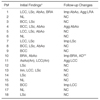1. Herrera EL, Seoane M. Lande A, Berkmen YM, McAllister HA, editors. Takayasu's arteritis (nonspecific aortitis). Aortitis: clinical, pathologic, and radiographic aspects. 1986. New York: Raven Press;173–191.
2. Arend WP, Michel BA, Bloch DA, Hunder GG, Calabrese LH, Edworthy SM, et al. The american college of rheumatology 1990 criteria for the classification of Takayasu arteritis. Arthritis Rheum. 1990. 8:1129–1134.
3. Park JH, Han MC, Kim SH, Oh BH, Park YB, Seo JD. Takayasu arteritis: angiographic findings and results of angioplasty. AJR Am J Roentgenol. 1989. 153:1069–1074.
4. Mandalam KR, Joseph S, Rao VR, Gupta AK, Unni NM, Rao AS, et al. Aortoarteritis of abdominal aorta: an angiographic profile in 110 patients. Clini Radiol. 1993. 48:29–34.
5. Hayashi K, Fukushima T, Matsunaga N, Hombo Z. Takayasu arteritis: decrease in aortic wall thickening following steroid therapy, documented by CT. Br J Radiol. 1986. 59:281–283.
6. Park JH, Chung JW, Im JG, Kim SK, Park YB, Han MC. Takayasu arteritis: evaluation of mural changes in the aorta and pulmonary artery with CT angiography. Radiology. 1995. 196:89–93.
7. Kerr GS, Hallahan CW, Giordano J, Leavitt RY, Fauci AS, Rottem M, et al. Takayasu arteritis. Ann Intern Med. 1994. 120:919–929.
8. Paul JF, Fiessinger JN, Sapoval M, Hernigou A, Mousseaux E, Emmerich J, et al. Follow-up electron beam CT for the management of early phase Takayasu arteritis. J Comput Assist Tomogr. 2001. 25:924–931.
9. Kissin EY, Merkel PA. Diagnostic imaging in Takayasu arteritis. Curr Opin Rheumatol. 2004. 16:31–37.
10. Wagner AD, Andresen J, Raum E, Lotz J, Zeidler H, Kuipers JG, et al. Standardized work-up programme for fever of unknown origin and contribution of magnetic resonance imaging for the diagnosis of hidden systemic vasculitis. Ann Rheum Dis. 2005. 64:105–110.
11. Park SH, Chung JW, Lee JW, Han MH, Park JH. Carotid artery involvement in Takayasu's arteritis: evaluation of the activity by ultrasonography. J Ultrasound Med. 2001. 20:371–378.
12. Tanigawa K, Eguchi K, Kitamura Y, Kawakami A, Ida H, Yamashita S, et al. Magnetic resonance imaging detection of aortic and pulmonary artery wall thickening in the acute stage of Takayasu arteritis. Improvement of clinical and radiologic findings after steroid therapy. Arthritis Rheum. 1992. 35:476–480.
13. Choe YH, Han BK, Koh EM, Kim DK, Do YS, Lee WR. Takayasu's arteritis: assessment of disease activity with contrast-enhanced MR imaging. AJR Am J Roentgenol. 2000. 175:505–511.
14. Virmani R, Lande A, McAllister HA. Lande A, Berkmen YM, McAllister HA, editors. Pathological aspects of Takayasu's arteritis. Aortitis: clinical, pathologic, and radiographic aspects. 1986. New York: Raven Press;173–191.
15. Wintersperger B, Jakobs T, Herzog P, Schaller S, Nikolaou K, Suess C, et al. Aorto-iliac multidetector-row CT angiography with low kV settings: improved vessel enhancement and simultaneous reduction of radiation dose. Eur Radiol. 2005. 15:334–341.
16. Kalva SP, Sahani DV, Hahn PF, Saini S. Using the K-edge to improve contrast conspicuity and to lower radiation dose with a 16-MDCT: a phantom and human study. J Comput Assist Tomogr. 2006. 30:391–397.











 PDF
PDF ePub
ePub Citation
Citation Print
Print


 XML Download
XML Download